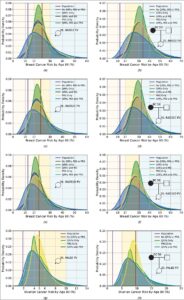Pathogenic variants in BARD1, RAD51C and RAD51D have recently been established as breast cancer susceptibility genes; and pathogenic variants in PALB2 have been shown to be associated with epithelial ovarian cancer risk. No cancer risk prediction model currently exists which incorporates these associations. Here, the BOADICEA multifactorial breast and ovarian cancer risk prediction model was extended to incorporate these associations and has been implemented in the CanRisk tool (www.canrisk.org) for use by healthcare professionals. The enhanced risk prediction model will enable healthcare professionals to provide personalised breast and epithelial ovarian cancer risks to BARD1, RAD51C, RAD51D and PALB2 pathogenic variant carriers and will allow for more informed choices on cancer risk management options. (By Dr. Antonis Antoniou, https://jmg.bmj.com/content/early/2022/09/21/jmedgenet-2022-108471 )
Enhancing the BOADICEA cancer risk prediction model to incorporate new data on RAD51C, RAD51D, BARD1 updates to tumour pathology and cancer incidence
(Visited 130 times, 1 visits today)
